清东陵(英文PPT简介)
- 格式:ppt
- 大小:8.13 MB
- 文档页数:31
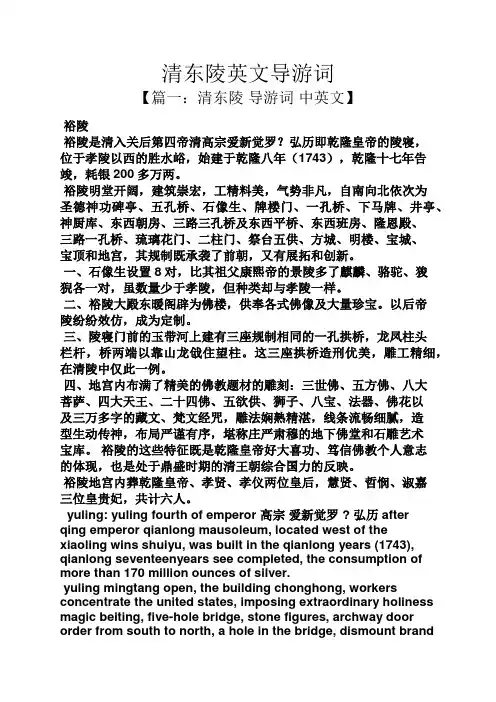
清东陵英文导游词【篇一:清东陵导游词中英文】裕陵裕陵是清入关后第四帝清高宗爱新觉罗?弘历即乾隆皇帝的陵寝,位于孝陵以西的胜水峪,始建于乾隆八年(1743),乾隆十七年告竣,耗银200多万两。
裕陵明堂开阔,建筑崇宏,工精料美,气势非凡,自南向北依次为圣德神功碑亭、五孔桥、石像生、牌楼门、一孔桥、下马牌、井亭、神厨库、东西朝房、三路三孔桥及东西平桥、东西班房、隆恩殿、三路一孔桥、琉璃花门、二柱门、祭台五供、方城、明楼、宝城、宝顶和地宫,其规制既承袭了前朝,又有展拓和创新。
一、石像生设置8对,比其祖父康熙帝的景陵多了麒麟、骆驼、狻猊各一对,虽数量少于孝陵,但种类却与孝陵一样。
二、裕陵大殿东暖阁辟为佛楼,供奉各式佛像及大量珍宝。
以后帝陵纷纷效仿,成为定制。
三、陵寝门前的玉带河上建有三座规制相同的一孔拱桥,龙凤柱头栏杆,桥两端以靠山龙戗住望柱。
这三座拱桥造刑优美,雕工精细,在清陵中仅此一例。
四、地宫内布满了精美的佛教题材的雕刻:三世佛、五方佛、八大菩萨、四大天王、二十四佛、五欲供、狮子、八宝、法器、佛花以及三万多字的藏文、梵文经咒,雕法娴熟精湛,线条流畅细腻,造型生动传神,布局严谨有序,堪称庄严肃穆的地下佛堂和石雕艺术宝库。
裕陵的这些特征既是乾隆皇帝好大喜功、笃信佛教个人意志的体现,也是处于鼎盛时期的清王朝综合国力的反映。
裕陵地宫内葬乾隆皇帝、孝贤、孝仪两位皇后,慧贤、哲悯、淑嘉三位皇贵妃,共计六人。
yuling: yuling fourth of emperor 高宗爱新觉罗 ? 弘历 afterqing emperor qianlong mausoleum, located west of thexiaoling wins shuiyu, was built in the qianlong years (1743), qianlong seventeenyears see completed, the consumption of more than 170 million ounces of silver.yuling mingtang open, the building chonghong, workers concentrate the united states, imposing extraordinary holiness magic beiting, five-hole bridge, stone figures, archway door order from south to north, a hole in the bridge, dismount brandjingting, kitchen god library, something toward the room, three three-hole bridge and things pingqiao things classrooms, en temple, three hole bridge, and glass flower door, the second wicket, the altar five for fangcheng, ming house, boseong , ding and the underground palace, the regulation only inherited the former, another exhibition billiton and innovation. stone figures set of eight pairs than its grandfather mausoleum of emperor 康熙 of the king, a pair of unicorn, camel, ni, although the number is less than xiaoling, but the species has xiaoling. yuling hall turned into east snappers buddha floor, dedicated to all kinds of statues and a large number of treasures. after the mausoleum to follow suit and become the custom. built mausoleum in front of yudai river the three regulation the same hole arch bridge, dragon and phoenix stigma railings, the bridge at both ends to the patron dragon berm live in hope pillar. this three-arch bridge in prison beautiful carving fine, only this one case in the qing mausoleum. , and intrauterine full of beautifully carved buddhist themes: buddhas of the five parties, the buddha, eight buddha, four kings, twenty-four buddhas, five desires for the lions, eight, instruments used, the buddha spent thirty thousand multi-word tibetan, sanskrit mantras, carved skillfully superb, delicate flowing lines, dynamic, vivid and expressive, disciplined layout, called the solemn underground temple and stone carving art treasure house. the yuling these characteristics both emperor qianlong grandiose manifestation of devout buddhist, the individual will, but also a reflection of the overall national strength in the heyday of the qing dynasty. the yuling intrauterine buried two queens of emperor qianlong, xiao xian, hsiao-yi, hui yin, philosophy of benjamin, shu jia three imperial concubine, a total of six people【篇二:清东陵导游词】清东陵各位朋友现在各位就随我已经进入了清东陵这块风水宝地,众所周知,清朝是中国最后一个封建王朝。
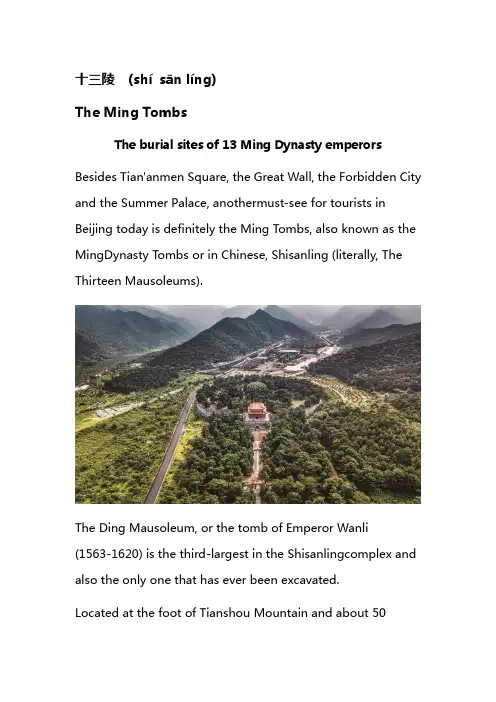
十三陵(shísān líng)The Ming TombsThe burial sites of 13 Ming Dynasty emperors Besides Tian'anmen Square, the Great Wall, the Forbidden City and the Summer Palace, anothermust-see for tourists in Beijing today is definitely the Ming Tombs, also known as the MingDynasty Tombs or in Chinese, Shisanling (literally, The Thirteen Mausoleums).The Ding Mausoleum, or the tomb of Emperor Wanli (1563-1620) is the third-largest in the Shisanlingcomplex and also the only one that has ever been excavated.Located at the foot of Tianshou Mountain and about 50kilometers northwest of downtownBeijing, this is the burial site of 13 emperors of the Ming Dynasty (1368–1644). Also, there aretombs of 23 empresses, two princes, more than 30 concubines and one eunuch of the dynasty.Covering an area of more than 120 square kilometers, this imperial burial site was chosen byEmperor Yongle (1360–1424), the third Ming emperor, who moved the capital from Nanjing (now capital of Jiangsu Province in east China) to Beijing in 1421, in order to better defend thenorthern territory.Of the 16 rulers of the Ming Dynasty, 13 were buried here. Of the other three, the first emperorwas buried in Nanjing, the original capital of the dynasty; the second emperor disappearedwithout a trace after he was overthrown, and the seventh emperor was later denied an imperialtomb at the site because he was deemed an "emperor pro tem."The Ming Tombs are widely considered a masterpiece and the best example of the traditionalChinese imperial mausoleums, which are known for their perfect combination of fine architectureand beautiful scenery.The site is dotted with numerous grandiose buildings on the surface, and underneath, there arelarge and well-designed tombs. Each of the 13 imperial mausoleums, from 0.5 to 8 kilometersapart, forms an independent unit. But as a group, they constitute a harmonious complexfeaturing buildings of traditional architectural design and decoration.Of the 13 imperial tombs in the complex, the ChangMausoleum, the tomb of Emperor Yongle, isthe largest and oldest. Situated on the southern slope of the main peak of Tianshou Mountain, itsarchitecture covers a total area of 120,000 square meters and features traditional imperialbuildings.The Ding Mausoleum, or the tomb of Emperor Wanli (1563–1620) or the 13th ruler of the Ming Dynasty, is the third-largest in the complex and also the only one that has ever been excavated.The excavation started in the spring of 1956 and was completed two years later. Archeologistsfound that the underground palace was about two stories tall and 80 meters long, housing threelarge coffins, one for Emperor Wanli and two for his two empresses.Also, the excavators had unearthed more than 3,000 artifacts made of silk, gold, silver, jade,porcelain and rare wood. Among them, there was a dragon crown elaborately knitted with finegold threads and a phoenix coronet embedded with precious stones.Unfortunately, due to lack of adequate technology, many of the excavated relics, such as silk andtextile items, quickly deteriorated and decomposed after being exposed to air. This is perhapsthe reason that China stopped excavating other imperial tombs.In addition to the mausoleums and tombs, there is a7-kilometer-long "spirit road" that leadsfrom south to north into the complex. It is the longest of its kind built in Chinese imperialmausoleums. It is also lined on both sides with giant stone statues of real and imaginary animalsand officials.At the southern tip of the entrance towers a freestanding marble gateway with five openings.Built in 1540 and decorated with intricate carvings, it is believed to be the most magnif icent ofits kind ever built in ancient China.In 2003, the Ming Tombs and tombs of the Qing Dynasty (1644–1911) were listed as a UNESCOWorld Heritage Site."The harmonious integration of remarkable architectural groups in a naturalenvironment chosen to meet the criteria of geomancy (fengshui) makes the Ming and QingImperial Tombs masterpieces of human creative genius," the organization said.The marble Paifangof the Ming Tombs has six pillars, five openings and 11 roofs. Pictorial dictionary·牌坊(pái fāng) freestanding gatewayPaifang, also called pailou, is a freestanding gateway used in ancient China to dignify an entranceor serve as a monument to extol distinguished individuals. Such gateways, usually builtof stone,marble, glazed terracotta, wood or sometimes metal, could be quite high, hence often serving aslandmarks. The gateways could have one, three or five openings, depending on how wide anentrance they span. On top, they may have one or multiple-level eaves. Pillars and beams areusually decorated with carvings.Built in 1540, the marble paifang at the entrance of the Ming Tombs in Beijing is widely deemedas one of the most monumental of its type. The oldest existing stone paifangis perhaps the onein Ningbo in east China's Zhejiang Province, believed to be built during the Southern SongDynasty (1127–1279).。
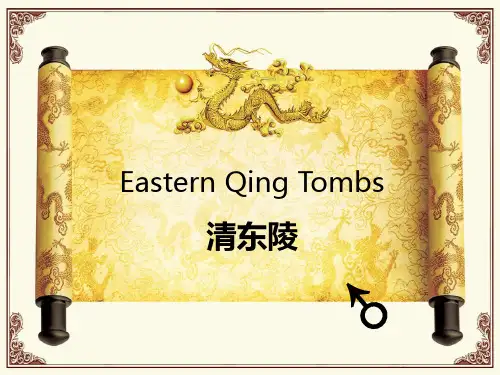
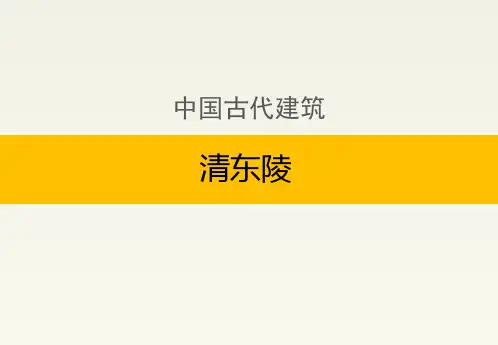

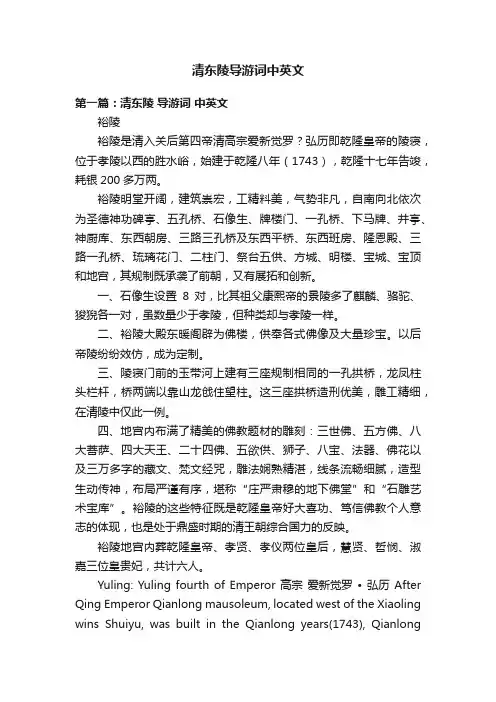
清东陵导游词中英文第一篇:清东陵导游词中英文裕陵裕陵是清入关后第四帝清高宗爱新觉罗?弘历即乾隆皇帝的陵寝,位于孝陵以西的胜水峪,始建于乾隆八年(1743),乾隆十七年告竣,耗银200多万两。
裕陵明堂开阔,建筑崇宏,工精料美,气势非凡,自南向北依次为圣德神功碑亭、五孔桥、石像生、牌楼门、一孔桥、下马牌、井亭、神厨库、东西朝房、三路三孔桥及东西平桥、东西班房、隆恩殿、三路一孔桥、琉璃花门、二柱门、祭台五供、方城、明楼、宝城、宝顶和地宫,其规制既承袭了前朝,又有展拓和创新。
一、石像生设置8对,比其祖父康熙帝的景陵多了麒麟、骆驼、狻猊各一对,虽数量少于孝陵,但种类却与孝陵一样。
二、裕陵大殿东暖阁辟为佛楼,供奉各式佛像及大量珍宝。
以后帝陵纷纷效仿,成为定制。
三、陵寝门前的玉带河上建有三座规制相同的一孔拱桥,龙凤柱头栏杆,桥两端以靠山龙戗住望柱。
这三座拱桥造刑优美,雕工精细,在清陵中仅此一例。
四、地宫内布满了精美的佛教题材的雕刻:三世佛、五方佛、八大菩萨、四大天王、二十四佛、五欲供、狮子、八宝、法器、佛花以及三万多字的藏文、梵文经咒,雕法娴熟精湛,线条流畅细腻,造型生动传神,布局严谨有序,堪称“庄严肃穆的地下佛堂”和“石雕艺术宝库”。
裕陵的这些特征既是乾隆皇帝好大喜功、笃信佛教个人意志的体现,也是处于鼎盛时期的清王朝综合国力的反映。
裕陵地宫内葬乾隆皇帝、孝贤、孝仪两位皇后,慧贤、哲悯、淑嘉三位皇贵妃,共计六人。
Yuling: Yuling fourth of Emperor 高宗爱新觉罗• 弘历 After Qing Emperor Qianlong mausoleum, located west of the Xiaoling wins Shuiyu, was built in the Qianlong years(1743), Qianlongseventeenyears see completed, the consumption of more than 170 million ounces of silver.Yuling Mingtang open, the building Chonghong, workers concentrate the United States, imposing extraordinary holiness magic Beiting, five-hole bridge, stone figures, archway door order from south to north, a hole in the bridge, dismount brand Jingting, kitchen god library, something toward the room, three three-hole bridge and things Pingqiao things classrooms, en Temple, three hole bridge, and glass flower door, the second wicket, the altar five for Fangcheng, Ming House, Boseong , ding and the underground palace, the regulation only inherited the former, another exhibition Billiton and innovation.Stone figures set of eight pairs than its grandfather Mausoleum of Emperor 康熙 of the King, a pair of unicorn, camel, Ni, although the number is less than Xiaoling, but the species has Xiaoling.Yuling hall turned into East Snappers Buddha floor, dedicated to all kinds of statues and a large number of treasures.After the Mausoleum to follow suit and become the custom.Built mausoleum in front of Yudai River the three regulation the same hole arch bridge, dragon and phoenix stigma railings, the bridge at both ends to the patron dragon berm live in hope pillar.This three-arch bridge in prison beautiful carving fine, only this one case in the Qing Mausoleum., And intrauterine full of beautifully carved Buddhist themes: Buddhas of the five parties, the Buddha, eight Buddha, four kings, twenty-four Buddhas, five desires for the Lions, Eight, instruments used, the Buddha spent thirty thousand multi-word Tibetan, Sanskrit Mantras, carved skillfully superb, delicate flowing lines, dynamic, vivid and expressive, disciplined layout, called the "solemn underground temple and stone carving art treasure house.The Yuling these characteristics both Emperor Qianlong grandiosemanifestation of devout Buddhist, the individual will, but also a reflection of the overall national strength in the heyday of the Qing Dynasty.The Yuling intrauterine buried two queens of Emperor Qianlong, Xiao Xian, Hsiao-yi, Hui Yin, philosophy of Benjamin, Shu Jia three imperial concubine, a total of six people 第二篇:清东陵导游词清东陵导游词各位游客大家好,首先欢迎大家来清东陵旅游,我是神龙旅行社的导游张圣熙。
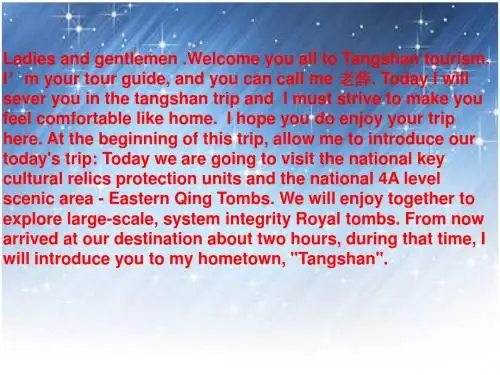
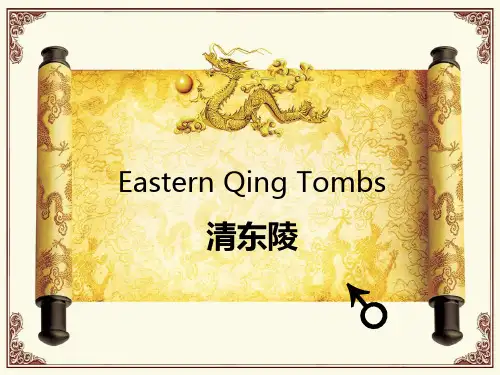
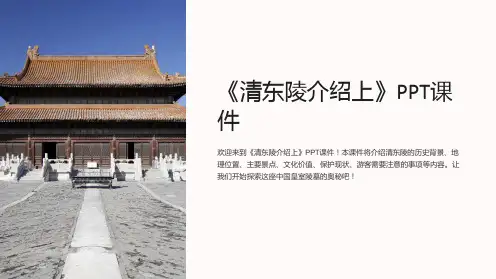
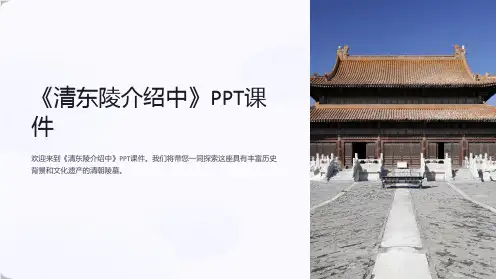
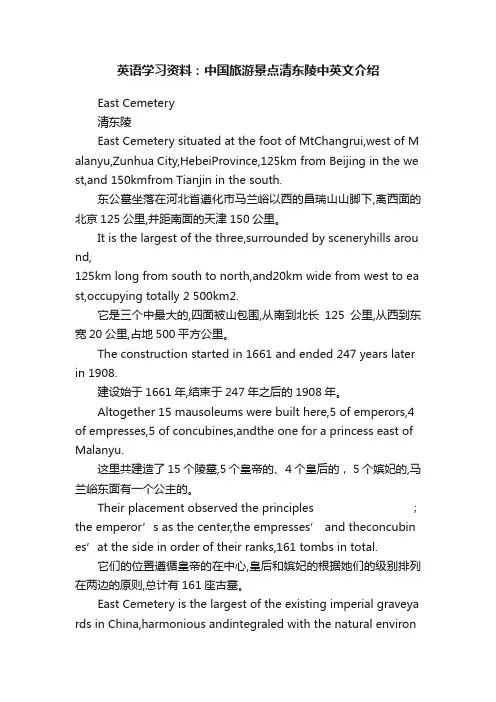
英语学习资料:中国旅游景点清东陵中英文介绍East Cemetery清东陵East Cemetery situated at the foot of MtChangrui,west of M alanyu,Zunhua City,HebeiProvince,125km from Beijing in the we st,and 150kmfrom Tianjin in the south.东公墓坐落在河北省遵化市马兰峪以西的昌瑞山山脚下,离西面的北京125公里,并距南面的天津150公里。
It is the largest of the three,surrounded by sceneryhills arou nd,125km long from south to north,and20km wide from west to ea st,occupying totally 2 500km2.它是三个中最大的,四面被山包围,从南到北长125公里,从西到东宽20公里,占地500平方公里。
The construction started in 1661 and ended 247 years later in 1908.建设始于1661年,结束于247年之后的1908年。
Altogether 15 mausoleums were built here,5 of emperors,4 of empresses,5 of concubines,andthe one for a princess east of Malanyu.这里共建造了15个陵墓,5个皇帝的、4个皇后的, 5个嫔妃的,马兰峪东面有一个公主的。
Their placement observed the principles;the emperor’s as the center,the empresses’ and theconcubin es’at the side in order of their ranks,161 tombs in total.它们的位置遵循皇帝的在中心,皇后和嫔妃的根据她们的级别排列在两边的原则,总计有161座古墓。
简介:清东陵(Eastern Royal Tombs of the Qing Dynasty)清东陵属全国重点文物保护单位,是中国最后一个王朝首要的帝王后妃陵墓群,也是中国现存规模最大、体系最完整的古帝陵建筑,共建有皇陵五座—顺治帝的孝陵、康熙帝的景陵、乾隆帝的裕陵、咸丰帝的定陵、同治帝的惠陵,以及东(慈安)、西(慈禧)太后等后陵四座、妃园五座、公主陵一座,计埋葬14个皇后和136个妃嫔。
清东陵坐落在河北省唐山市的遵化市境内,占地78平方公里,是我国现存规模最宏大、体系最完整、布局最得体的帝王陵墓建筑群由陵区最南端的石牌坊向北到孝陵宝顶,由一条约12公尺宽、6公里长的神道连成一气,沿途大红门、大碑楼(圣德神功碑楼)、石像生、龙凤门、七孔桥、小碑楼(神道碑楼)、隆恩门、隆恩殿、方城明楼等建筑井然有序,主次分明。
清东陵是一块难得的"风水"宝地。
北有昌瑞山做后靠如锦屏翠帐,南有金星山做朝如持芴朝揖,中间有影壁山做书案可凭可依,东有鹰飞倒仰山如青龙盘卧,西有黄花山似白虎雄踞,东西两条大河环绕夹流似两条玉带。
群山环抱的堂局辽阔坦荡,雍容不迫,真可谓地臻全美,景物天成。
当年顺治到这一带行围打猎,被这一片灵山秀水所震撼,当即传旨"此山王气葱郁可为朕寿宫"。
从此昌瑞山便有了规模浩大、气势恢宏的清东陵。
坐标:40°08′~40°11′北 117°37′~117°42′东陵寝格局清东陵的15座陵寝是按照“居中为尊”、“长幼有序”、清东陵格局示意图“尊卑有别”的传统观念设计排列的。
入关第一帝世祖顺治皇帝的孝陵位于南起金星山,北达昌瑞山主峰的中轴线上,其位置至尊无上,其余皇帝陵寝则按辈分的高低分别在孝陵的两侧呈扇形东西排列开来。
孝陵之左为圣祖康熙皇帝的景陵,次左为穆宗同治皇帝的惠陵;孝陵之右为高宗乾隆皇帝的裕陵,次右为文宗咸丰皇帝的定陵,形成儿孙陪侍父祖的格局,突现了长者为尊的伦理观念。
清东陵简介清东陵,位于河北省遵化市西北部马兰峪的昌瑞山,距离北京125公里、天津150公里,是中国最后一个封建王朝——清朝三大陵园中最大的一座。
共有帝陵5座,即世祖顺治帝之孝陵、圣祖康熙帝之景陵、高宗乾隆帝之裕陵、文宗咸丰帝之定陵、穆宗同治帝之惠陵。
此外,孝庄皇后的昭西陵、孝惠章皇后的孝东陵、慈安太后的普祥峪定东陵及慈禧太后的普陀峪定东陵4座皇后陵也建在此。
另有妃园寝5座,公主陵1座,共计埋葬5位皇帝、14位皇后、136为妃嫔以及皇子、公主等共161人。
除陵寝外,清东陵还有十里神道、石牌坊、大红门、具服殿、神功圣德碑、龙凤门、五音桥、小碑亭、隆恩殿、明楼、月牙城和地宫等建筑。
据说清东陵是顺治到此打猎时选定的,康熙2年(1663年)开始修建。
陵区南北长125公里、宽20公里,四面环山,正南烟炖、天台两山对峙,形成宽仅50公尺的谷口,俗称龙门口。
清代在此陆续建成217座宫殿牌楼,组成大小15座陵园,诸陵园以顺治的孝陵为中心,排列于昌瑞山南麓,均由宫墙、隆恩门、隆恩殿、配殿、方城明楼及宝顶等建筑构成。
其中方城明楼为各陵园最高的建筑物,内立石碑,碑上以汉、满、蒙三种文字刻写墓主的谥号;明楼之后为“宝顶”(大坟头),其下方是停放灵柩的“地宫”。
由陵区最南端的石牌坊向北到孝陵宝顶,由一条约12公尺宽、6公里长的神道连成一气,沿途大红门、具服殿、神功圣德碑亭、石像生、龙凤门、单孔桥、七孔桥、五孔桥、三路三孔神道桥、神道碑楼、隆恩门、隆恩殿、方城明楼等建筑井然有序,主次分明。
清东陵是一块难得的“风水”宝地。
北有昌瑞山做后靠如锦屏翠帐,南有金星山做朝如持芴朝揖,中间有影壁山做书案可凭可依,东有鹰飞倒仰山如青龙盘卧,西有黄花山似白虎雄踞,东西两条大河环绕夹流似两条玉带。
群山环抱的堂局辽阔坦荡,雍容不迫,真可谓地臻全美,景物天成。
当年顺治到这一带行围打猎,被这一片灵山秀水所震撼,当即传旨“此山王气葱郁可为朕寿宫”。
从此昌瑞山便有了规模浩大、气势恢宏的清东陵。
河北4A级景区000-1:清东陵A-基本信息B-基本介绍清东陵(Eastern Royal Tombs of the Qing Dynasty)清东陵属全国重点文物保护单位,是中国最后一个王朝首要的帝王后妃陵墓群,也是中国现存规模最大、体系最完整的古帝陵建筑,共建有皇陵五座—顺治帝的孝陵、康熙帝的景陵、乾隆帝的裕陵、咸丰帝的定陵、同治帝的惠陵,以及东(慈安)、西(慈禧)太后等后陵四座、妃园五座、公主陵一座,计埋葬14个皇后和136个妃嫔C-景点清单0001孝陵神路孝陵神路南起金星山下的石牌坊,北到昌瑞山下的宝城、室顶,沿朝山、案山、靠山的三山连线,将孝陵的数十座形制各异、多彩多姿的建筑相贯串,形成一条气势宏伟、序列层次丰富、极为壮观的陵区建筑中轴线。
它虽然因势随形,多有曲折,但曲不离直,明确显现了南北山向的一贯,配合了山川形势,强化了主宾朝揖的天然秩序,产生了极富感染力的空间艺术效果。
孝陵神路是清陵中最长的神路,也是最壮观、最富艺术性的神路。
0002孝陵石牌坊仿木结构形式,五间六柱十一楼,面阔31.35米,高12.48米,全部用巨大的青白石构筑而成。
夹杆石的顶部圆雕麒麟、狮子,看面分别浮雕云龙、草龙、双狮戏球等图案。
梁枋上雕刻旋子彩画。
折柱、花板上浮雕祥云。
斗拱、椽飞、瓦垅、吻兽、云墩、雀替均为石料雕制,做工细巧,刻技精湛,历经数百年毫无走闪之迹,像这样高大精美的石牌坊,在国内已不多见。
0003孝陵石像生孝陵石像生共18对,其中文臣3对、武将3对、站卧马各1对、站坐麒麟各1对、站卧象各1对、站卧骆驼各1对、站坐鋑猊各1对、站坐狮子各1对。
另有望柱1对。
所有石雕像均以整块石料雕成。
不刻意追求形似,而注重神似,其风格粗犷、雄浑、朴拙、威武,气度非凡。
这组石雕对称地排列在神道两侧,南北长800多米,构成威武雄壮的长长队列,使皇陵显得更加圣洁、庄严、肃穆。
孝陵石像生是清代陵寝中规模最大、最具特色的一组。